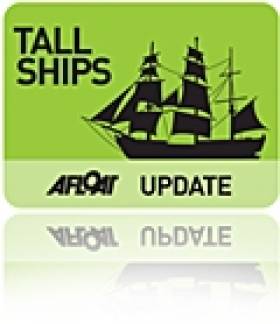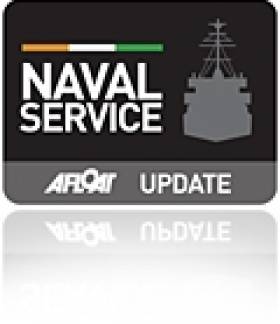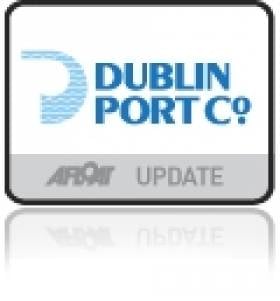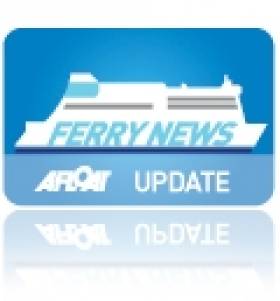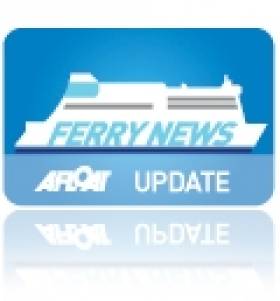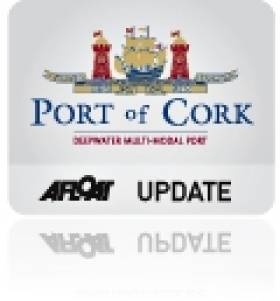Displaying items by tag: The Gathering
Celtic Mist in Dun Laoghaire Ready For Gathering Cruise
#CelticMist - The Irish Whale and Dolphin Group's (IWDG) research yacht Celtic Mist is currently docked in Dun Laoghaire awaiting the start of The Gathering Cruise around Ireland.
As previously reported on Afloat.ie, the 19-day event will see some 100 cruising boats proceed along the east and south coasts of Ireland from Dublin to Cork and Kerry.
Along the way they will be recording any sightings of whales or dolphins along the way using forms supplied by the IWDG.
Celtic Mist will join the flotilla as it departs Dun Laoghaire Harbour on 18 July headed for Kinsale on 24 July, and a second leg from Kinsale to Dingle from 25 July to 1 August.
And the IWDG is currently offering places on board to all members for both week-long legs of the cruise.
The vessel has eight berths that will comfortably sleep a team of one skipper and seven crew - indeed, anyone taking up this offer will be expected to prepare meals and perform other sailing duties!
For more details on how to join The Gathering Cruise on board Celtic Mist, see the IWDG website HERE.
In the meantime, Celtic Mist is offering all IWDG members a chance to sail on day trips from Dun Laoghaire this week - email [email protected] for details.
#AircraftCarrier – During the rare visit of the Royal Navy's HMS Illustrious (R06) to Dublin Port (PHOTO's) at the weekend, the last serving 'Invincible' class aircraft-carrier was given a Gathering welcome with a showering of green light, writes Jehan Ashmore.
The 22,000 displacement tons former aircraft-carrier which currently serves in the role as a High Readiness Helicopter and Commando Carrier, had called to the capital having completed Exercise Joint Warrior, a multi-national event involving several navies, off the coast of Scotland.
The 35 year old vessel which berthed at Alexandra Basin, was floodlit in green (as it happens, aptly on her starboard side) from lamps laid alongside Ocean Pier.
The special lighting effects were created by the Worshipful Company of Lightmongers with whom 'Lusty' as she is affectionately known by her 700 crew have a close affiliation to.
Niall Gibbons, CEO Tourism Ireland, said: "We were delighted to welcome HMS Illustrious to Ireland and are sure that the sailors on board received a wonderful Irish welcome during their stay."
During her visit, two members of the Ship's Company, Able Seaman Andrew Liston, 25, from Chesterfield and Able Seaman Aaron Canwell, 31, from Wembley, were both awarded certificates of Irish Heritage for having family ties to the country.
Another highlight of their 'Gathering' visit was a performance by Irish group, Ragus, who transformed the ship's hangar into a stage filled with traditional Irish music and dance.
HMS Illustrious was launched in 1978 from Swan Hunter on the Tyne and for most of her career spanning more than three decades the 209m long vessel had on board the famous 'Harrier' VSTOL jump-jets aircraft.
The Portsmouth based vessel is one of four Royal Navy core amphibious vessels, however she is due to pay off in 2014 and in her place are a pair of Queen Elizabeth class 65,000 tons aircraft –carriers currently under construction.
Until these newbuilds are delivered, HMS Ocean (L12) a helicopter carrier of 21,500 tons which has called to Dublin Port on previous occasions, is to replace the Lusty after completion of a £65m refit at Devonport Royal Dockyard early next year.
Yesterday HMS Illustrious departed Dublin Port as did all the other visiting navies which took part in Exercise Joint Warrior, except for the French Navy's oil replenishment tanker Marne which made an exodus this afternoon.
#FlagshipVisit – The Naval Service 'flagship' L.E Eitnne (P31) is to take part in the In Humbert's Footsteps, Mayo's flagship Gathering event, when the festival is to be held in August.
The vessel will sail into Kilcummin, Mayo (weather permitting) on Saturday August 17 and will provide a wonderful backdrop to what promises to be an exciting re-enactment of the events of 1798.
Mayo native Commodore Mark Mellett (DSM), Flag Officer Commanding Naval Services said: "I am delighted that the Minister for Defence and the Chief of Staff have sanctioned the use of the Irish naval service flagship LÉ Eithne for the Gathering event In Humbert's Footsteps. For more the Mayo Advertiser has a report.
#Cruiseliners -Discovery not only has the distinction of becoming the first cruise caller to Dublin Port in 2013 but also under the brand of Cruise & Maritime Voyages, writes Jehan Ashmore.
The 700 passenger capacity vessel docked today at Ocean Pier having departed her homeport of Avonmouth yesterday for the start of this year's cruise season.
Discovery of 20,000 tonnes and built in 1972 will be followed by fleetmate Marco Polo with a call on Friday to Dublin Port where the port is to welcome another record-breaking season with around 100 calls, with the Gathering being a major visitor draw.
As previously reported on Afloat.ie the giant 2010 built $547m MSC Magnifica of 95,000 tonnes which has more than 1,500 cabins accommodating a maximum 3,223 passengers, is to make her maiden 'Irish' call in late May.
The 294m 'Musica' class vessel is a larger fleetmate of Mediterranean Shipping Company's MSC Lirica, which last year also made a debut docking to Dublin Port and Cobh.
Other large callers to Dublin Port are Caribbean Princess, Celebrity Infinity and Queen Elizabeth which made her inaugural Irish call in 2011.
In addition The World, which also makes a return to the capital following her first ever call to Galway Harbour with an 'anchorage' call in early July.
Last year approximately 90 individual cruise calls were made to the capital which welcomed 100,000 passengers and brought between them €35-50m to the local economy.
With the increase in calls during 2013, the Dublin Port Company is to address future demand through its Masterplan 2012-2040, with a proposed new dedicated cruise terminal completed by 2015.
The facility would be sited along North Wall Quay Extension close to the East Link Bridge.
Ferries Get Red Noses & Turn All Green!... for Weekend Events
#FerryColourful – This weekend saw a Stena Line ferry or two getting big Red Noses and turning Green –well almost!...to mark the UK's Red Nose Day and Ireland's St. Patrick's Day.
Red Nose Day which celebrated its 25th anniversary this year was held last Friday and despite the economic climate, the charity fundraiser appeal raised a staggering £75m.
On board Stena ferries a host of fundraising activities took place including a range of specially created red nose muffins, sales of which along with other activities will go to Comic Relief.
Around the World the iconic images including the Pyramids of Giza and Leaning Tower of Pisa are to turn green this weekend for St Patrick's Day festivities.
Closer to home, Stena Line didn't want to turn green with envy so they turned out one of their Belfast-Birkenhead ferries to a shade of green instead... albeit with some imagination!
The Gathering Looms Ever Closer as Celtic Horizon Heads for St. Patrick’s Festivities
#GatheringVoyage –Passengers today on board Celtic Horizon which is due to make a lunchtime arrival in Rosslare Harbour are taking advantage of a special celebratory 'Gathering' sailing, writes Jehan Ashmore.
As previously reported, Celtic Link Ferries had been promoting a €1 euro motorist fare on this particular crossing which departed Cherbourg yesterday in advance of St. Patrick's Day festivities held across the nation in this year of The Gathering.
In addition to Irish and continental passengers, there are representatives from the tourism sector travelling on this Gathering sailing.
As the Celtic Horizon heads towards the Tuskar Rock Lighthouse, there will no doubt be an on board atmosphere of excitement as the Emerald Isle looms increasingly closer.
Celtic Horizon is the newest and fastest vessel operating on the French-Irish route and among the facilities are the aptly named Tuskar Lounge, Rosslare Bar and Cherbourg Café.
Ferry Operator Rolls Out Green Carpet to ‘Gathering’ Tourists
#FERRY & COACH – In support of the Government's 'The Gathering' initiatives, Irish Ferries is rolling out its own 'green carpet' in pledges worth up to EUR60,000, so to attract overseas visitors from Britain to Ireland this year.
Commenting on the pledges, Irish Ferries Head of Passenger Sales, Dermot Merrigan said "As Ireland's national sea carrier, we plan to play our part in attracting groups from our biggest overseas tourism market – Britain – and ensure that tourism providers around the country benefit to the greatest extent possible from the Government's plan".
First of the support packages, are 100 free return coach spaces that have been set aside on its Holyhead-Dublin and Pembroke Dock-Rosslare routes this year, to support groups wishing to attend the year-long Gathering of events.
Valued at up to GB£50,000 and available to eligible groups participating in officially registered events, this offer is billed as just one of a selection of 'green carpet' offers which the company plans to make available as part of a programme of support for this initiative.
The offer is for a free return carriage to Ireland for groups travelling with coaches, which includes -small mini buses to vehicles with seating for up to 30 passengers. With free coach spaces on offer for travel every week, spread across the entire year, potentially providing free transport for up to 3,000 tourists.
Merrigan added "this allocation of 100 free return coach spaces is the first shot in what we intend will be a number of 'green carpet' offers that we will roll out between now and year end."
Groups wishing to apply for the free transport and on how to make an application should visit www.irishferries.com/thegathering
Port Of Cork Schools Initiative Focuses On The Gathering For 2013
Calling all 5th Class Teachers – Win a Free Boat Trip around Cork Harbour for your class
The Port of Cork has launched their Schools Initiative for 2013 and is calling on all 5th class primary school teachers to get their class involved. This year's theme 'The Gathering 2013 – Cork Harbour – Ireland's Maritime Gateway to the World' is celebrating The Gathering and Cork Harbour's strong links with Irish diaspora, both as a tourism hub today and as a departure point for Irish emigrants in the past.
The Port of Cork Schools Initiative aims to teach 5th class primary school children about the rich history of Cork Harbour and its uses today as a natural harbour, commercial port and excellent leisure amenity. All participating 5th classes who take part in the Port of Cork Schools Initiative will be treated to a boat trip around Cork harbour, compliments of the Port of Cork and each class will also receive a certificate of participation. In addition to the overall prize, awards will also be given for the best artwork piece and best photograph. The overall best project will receive a tour on board one of the many large cruise liners visiting Cork during the summer of 2013.
Speaking about the 2013 theme, Port of Cork Chief Executive Brendan Keating said: "As 2013 is the year of 'The Gathering', we are encouraging classes to think about Cork Harbour and its role as Ireland's maritime gateway to the world both as a departure point for emigrants in the past and as a gathering point for tourists today. Cork Harbour has a long association as the departure point for many Irish emigrants in the 1800s and in the 1900s. Now thousands of visitors come into our spectacular harbour on passenger ferries and on cruise liners from all over the world. For many of these tourists, their visit also provides them with the opportunity to see the place that their Irish ancestors departed from so many years ago."
Projects are to be presented in artwork format using paintings, models or photographs. Submitted projects will go on public display in Customs House before the winner is announced in April 2013. Closing date for entries is 29th March 2013.
For more information on this year's schools project and how to get involved, please contact Sinead Kavanagh, Tel: +21 4625375 or email [email protected].
'The Gathering' Cruise to Attract 100 Boats for East and South Coast Voyage
#cruising – A 19–day event next July 2013 with 100 cruising boats and 600 crew members will form the Gathering Cruise along the east and south coasts of Ireland.
The Irish Sailing Association (ISA) and the Gathering Ireland 2013 today announced details of the Gathering Cruise 2013. The event aims to bring together a flotilla of yachts from across the UK, Europe and further afield as they sail to Irish ports as part of Gathering Ireland 2013.
The Gathering Cruise, which will commence in Dublin, is expected to continue along the Cork and Kerry coastlines and the Irish Sailing Association hope it will be an opportunity to raise awareness of Ireland's marine tourism infrastructure while profiling Ireland's stunning coastline and coastal towns as a cruising destination for both sail and power boats.
Project Director of The Gathering Ireland 2013 Jim Miley "The Gathering Ireland is delighted to announce this high seas partnership. The sailing community is such an important part of Ireland's tourism industry and this innovative partnership and Gathering Cruise will form a key part of the Gathering Ireland 2013 calendar. The Gathering Cruise also captures what the Gathering Ireland is about- bringing people who have an interest or a link to Ireland in 2013 to be part of it."


























